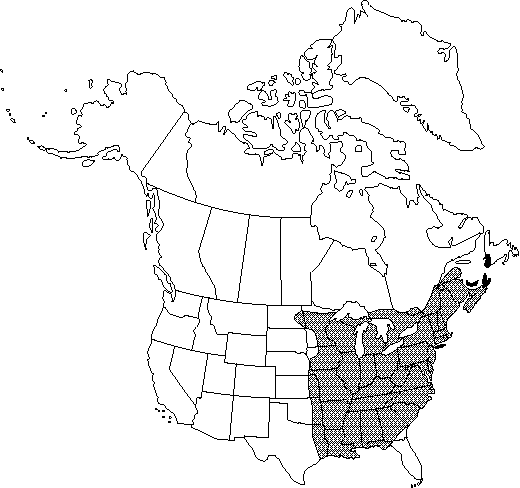Ranunculus recurvatus var. recurvatus
Stems erect, never rooting nodally, hirsute, base bulbous, cormlike. Roots never tuberous. Basal leaf-blades broadly cordate in outline, 3-cleft or parted, 2-7.5 × 3-11.6 cm, segments undivided or shallowly 1-2-cleft, ultimate segments rhombic, margins crenate-toothed, apex acute or obtuse. Flowers: receptacle hispid; sepals reflexed from near base, 3-6 × 1.5-2.5 mm, pilose; petals 5, yellow, 3-5 × 1-2 mm. Heads of achenes globose, 5-6 mm wide; achenes 1.6-2.2 × 1.4-1.8 mm, glabrous, margin forming narrow rib 0.1-0.2 mm wide; beak persistent, lanceolate, curved, hooked, 1-1.4 mm. 2n = 32.
Phenology: Flowering spring (Apr–Jun).
Habitat: Mesic woods, stream banks, and swamps
Elevation: 0-1200 m
Distribution

N.B., Nfld. and Labr. (Nfld.), N.S., Ont., P.E.I., Que., Ala., Ark., Conn., Del., D.C., Fla., Ga., Ill., Ind., Iowa, Kans., Ky., La., Maine, Md., Mass., Mich., Minn., Miss., Mo., Nebr., N.H., N.J., N.Y., N.C., N.Dak., Ohio, Okla., Pa., R.I., S.C., Tenn., Tex., Vt., Va., W.Va., Wis.
Discussion
The Cherokee used Ranunculus recurvatus var. recurvatus as a sedative, a dermatological aid, and an oral aid; the Iroquois, as a laxative, a venereal aid, and a toothache remedy (D. E. Moerman 1986).
Selected References
None.
Lower Taxa
"high" is not a number.